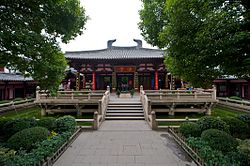Dharma Hall
| Dharma Hall | |||||||
|---|---|---|---|---|---|---|---|
 | |||||||
| Chinese name | |||||||
| Chinese | 法堂 | ||||||
| |||||||
| Vietnamese name | |||||||
| Vietnamese alphabet | Pháp Đường | ||||||
| Chữ Hán | 法堂 | ||||||
| Korean name | |||||||
| Hangul | 법당 | ||||||
| Hanja | 法堂 | ||||||
| |||||||
| Japanese name | |||||||
| Kanji | 法堂 | ||||||
| |||||||
The Dharma Hall is a central building in East Asian Buddhist temples where teachings are delivered, scriptures are expounded, and assemblies are held. It serves as a space for disseminating Buddhist doctrines, often second in importance only to the Mahavira Hall. The hall typically features a elevated seat for the abbot or presiding monk, a lecture table, and symbolic decorations such as lion paintings (representing the "lion's roar" of Dharma propagation). Dharma Hall is called Fatang (法堂; Fǎtáng) in China, Hōdō (法堂) in Japan, Beopdang (법당) in Korea, and Pháp Đường in Vietnam.
China
[edit]In Chinese Buddhism, the Dharma Hall is a key structure in traditional temple layouts. During the Song dynasty, it was included in the "Seven-Hall" temple plan. Architecturally, it resembles other temple halls but is designed for spaciousness and brightness, with a high platform for the lecturer, a seating arrangement, and instruments like bells and drums. The hall primarily hosts lectures and rituals rather than enshrining specific deities. It may contain a Buddha image on the lecture table and a painting or screen of a lion behind the platform, symbolizing the power of Dharma propagation. The Dharma Hall is the place for senior monks to preach and generally ranks right after the Mahavira Hall.[1] With the similar architecture form with other halls, the Dharma Hall is more spacious.[1] In the central back, there is a high platform with a sitting chair putting in the middle.[1] In front of the chair is a table with a small sitting Buddha on it, behind the platform is a screen or a picture of lion which is also known as "Roaring lion" (獅子吼), hung on the wall.[1] Seats are placed on both sides of the platform with bells and drums for senior monks to beat when they are preaching.[1] There are also seats on both sides of the monks' seats for laymen to listen to the Buddha Dharma by senior monks.[2][3] White Horse Temple in Luoyang, one of China's earliest Buddhist temple, included a Dharma Hall as part of its classical layout.
Japan
[edit]In Japan, the Dharma Hall evolved under Zen Buddhism, emphasizing simplicity and functionality. An example is the Tōdai-ji in Nara, originally built in the 8th century (740–747 CE) and expanded in 1199. It combines a rear sanctum and a front worship hall, showcasing Japanese Buddhist architecture with hip-roofs, wooden pillars, and minimalist aesthetics. The Dharma Hall at Tōdai-ji enshrines the Fukūkensaku Kannon (不空羂索観音, Amoghapāśa) as the central image, flanked by guardians like Niō, Shitennō, and Shukongōshin. These statues reflect Nara-period sculptural art.
Korea
[edit]In Korean, Dharma Hall serve as multi-functional spaces for sermons and rituals. They often adopt traditional timber-frame structures with curved roofs and ornate brackets. Example includeBeopheung-sa in Gangwon Province, established in 647 during the Silla dynasty. The hall integrates with natural surroundings, using mountain terrain for symbolic resonance. While Dharma Hall may house Buddha images, some unique halls focus on relics. For instance, Beopheung-sa's "Sil-myeol Bo-gung" (Nirvana Treasure Palace) enshrines sarira (relics) of the Buddha instead of statues, treating the entire mountain as a sacred embodiment of the Buddha. Buseok-sa and Songgwang-sa have historic Dharma Halls.
Vietnam
[edit]In Vietnamese Buddhism, Dharma Hall blends Sino-Vietnamese architecture, featuring curved roofs, wooden trusses, and axial layouts. They appear in major temples like Thiên Mụ Pagoda (Chùa Thiên Mụ) in Huế, built in 1601 under the Nguyễn Lords. The hall lies within a complex of gates, bell towers, and shrines, reflecting Vietnamese adaptations of Chinese Buddhist norms. The hall may contain altars for Buddha, bodhisattvas, or local deities. At Thiên Mụ Pagoda, the Dharma Hall is part of a larger complex including a Main Shrine with Buddha images, Ksitigarbha Hall, and a stone stele carried by a tortoise. It is a UNESCO World Heritage site with a historic Dharma Hall and iconic octagonal tower.
References
[edit]- ^ a b c d e Zi Yan (2012-08-01). Famous Temples in China. Beijing: Time Publishing and Media Co., Ltd. p. 35. ISBN 978-7-5461-3146-7.
- ^ Wei Ran (2012-06-01). Buddhist Buildings. Beijing: China Architecture & Building Press. ISBN 9787112142880.
- ^ Han Xin (2006-04-01). Well-Known Temples of China. Shanghai: The Eastern Publishing Co. Ltd. ISBN 7506024772.
Further reading
[edit]- Wang Guixiang (2016-06-17). 《中国汉传佛教建筑史——佛寺的建造、分布与寺院格局、建筑类型及其变迁》 [The History of Chinese Buddhist Temples] (in Chinese). Beijing: Tsinghua University Press. ISBN 9787302427056.
- Zhang Yuhuan (2014-06-01). 《图解中国佛教建筑、寺院系列》 (in Chinese). Beijing: Contemporary China Publishing House. ISBN 9787515401188.